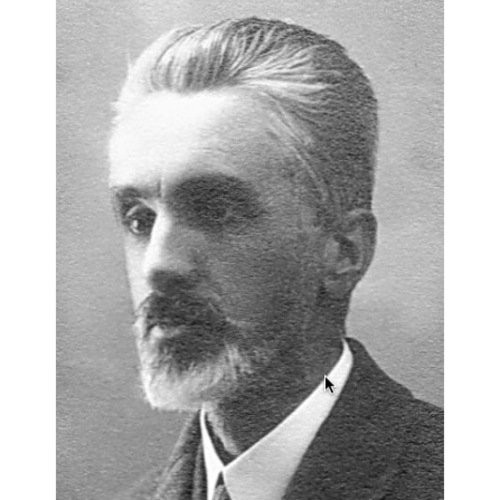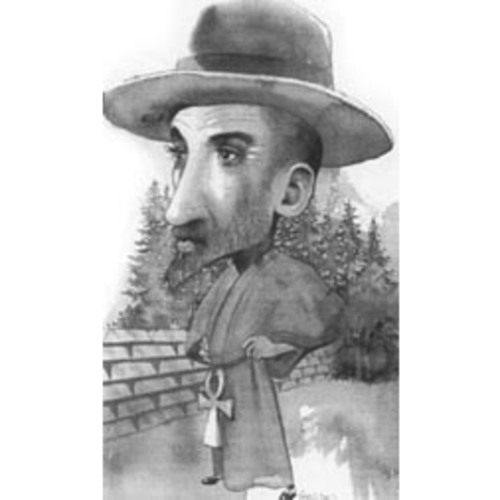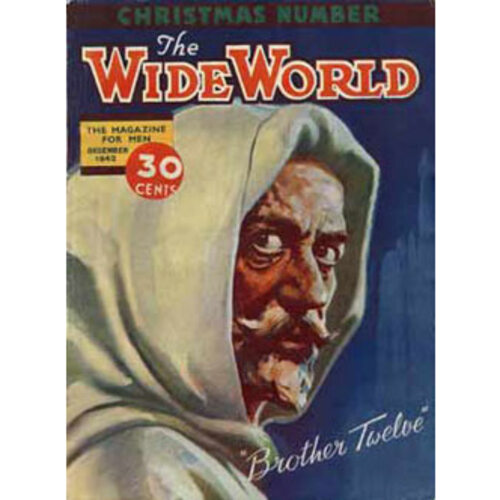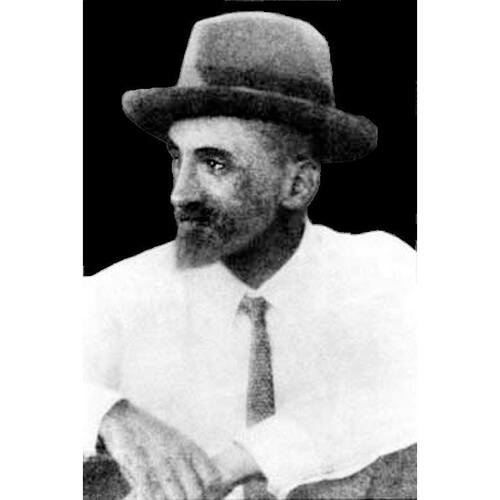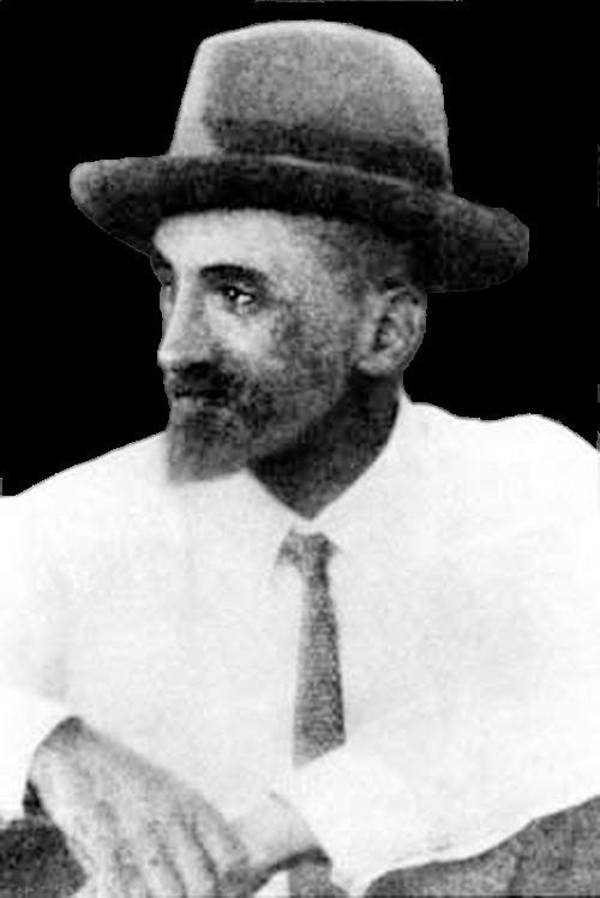
Source: Link
WILSON, EDWARD ARTHUR (also known as Brother XII and The Brother, XII, and colloquially as Brother Twelve; on 23 March 1931 he legally changed his name to Amiel de Valdes), mystic and cult leader; b. 25 July 1878 in Birmingham, England, son of Thomas Wilson, a master craftsman, and Sarah Ellen Pearsall; m. 24 Dec. 1902 Margery Clark in Wellington, New Zealand, and they had a son and a daughter; d. 7 Nov. 1934 in Neuchâtel, Switzerland, or later.
Brother XII was one of the most intriguing cult figures of the 20th century and has been described by Professor James A. Santucci as “sharing the brilliance of an L. Ron Hubbard, the destructiveness of a Jim Jones … and the hypnotic hold of a Rasputin.” His group was a prototype of the new religious movements that would be founded by charismatic leaders in the second half of the century.
Originally named Edward Arthur Wilson, he was raised in the Catholic Apostolic Church and was heavily influenced by its apocalyptic teachings. A natural mystic, he would claim to have been in touch from an early age with higher beings and subtle worlds. Apprenticed as a youth on a Royal Navy sailing ship, he travelled the seas as a mariner, navigator, and eventually captain. During his voyages he immersed himself in the study of metaphysics and world religions, especially the teachings of the Theosophical Society. In 1907 he moved with his wife and children to British Columbia, where he held various jobs, including that of ship’s pilot. By his own account, in 1912 he passed through a “Ceremony of Dedication” during which he learned of his occult mission. He thereafter abandoned his family, who returned to their native New Zealand, and he resumed his wanderings and study, ostensibly to ready himself for the spiritual work to which he would later be called.
While staying in the south of France in the autumn of 1924, impoverished and in ill health, Wilson heard the voice of an Egyptian deity telling him to prepare for his great task. This epiphany was followed by an intense period of automatic writing and inspirational contact with a higher being who identified himself as a “Master of Wisdom” in an occult brotherhood known as the Great White Lodge, believed by Theosophists to guide the evolution of humanity. In 1925 Wilson began to receive from this entity teachings that he would publish the following year as The three truths: a simple statement of the fundamental philosophy of life as declared and shown to “Brother XII” (the personal chêla of a Master) (London). In 1926 he also published A message from the Masters of the Wisdom (London), the manifesto of the movement for which he was the spokesperson. As representative of the twelfth brother in the Great White Lodge, he took the name The Brother, XII. Under the pseudonym E. A. Chaylor, Wilson wrote a number of articles in the Occult Review (London), the world’s foremost occult journal; these created a sensation in esoteric circles. Capitalizing on this publicity, Brother XII set about recruiting members into the Aquarian Foundation, which he claimed would carry out the work of the lodge and be a literal “Ark of Refuge” in the devastation that he predicted would overwhelm western civilization.
In the spring of 1927 Brother XII arrived in British Columbia, where he established the headquarters of the Aquarian Foundation at Cedar-by-the-Sea (Cedar), seven miles south of Nanaimo on Vancouver Island. The society was granted a charter by the provincial government on 16 May. By the end of the summer the foundation numbered about 1,250 members in Canada and the United States, in addition to a core of several dozen followers who resided at the colony’s headquarters. Attracted by Brother XII’s persuasive prose and personal charisma, many wealthy and socially prominent individuals joined the foundation, several building expensive homes at Cedar-by-the-Sea.
Brother XII was also active in politics. Although by later standards he would be considered anti-Semitic and anti-Catholic, his articles found a receptive audience. He argued that the world was moving rapidly toward global dictatorship and warned that a network of interlocking monopolies would concentrate power in the hands of a few individuals who would control the fate of the planet. He used the foundation’s monthly magazine, the Chalice (Nanaimo), first issued in November 1927, as a platform for his political views. In January 1928 he travelled to Washington, D.C., to solicit support for a third party in the United States, aligning himself with Protestant groups, the Ku Klux Klan, and disaffected political elements that were opposed to the presidential candidacies of both Herbert Clark Hoover and Alfred Emmanuel Smith (whose Roman Catholicism was a divisive issue in that year’s campaign).
At Cedar-by-the-Sea Brother XII lived with Elma Wilson, whom he presented as his wife though they were never legally married. In July 1928 he initiated an affair with Myrtle Baumgartner, née Wells, the wife of a New York physician, claiming that they were the reincarnations of the Egyptian gods Osiris and Isis and that their child would become a world teacher in 1975. Baumgartner miscarried twice and afterwards suffered a mental breakdown. Brother XII’s infidelity precipitated a crisis among the members, which was exacerbated when he was accused in October by the foundation’s governors of misappropriating a $25,000 contribution from a wealthy supporter, Mary Wortham Connally, née Thomas. The charge was dismissed the following month when she testified in court that the money was a gift. In a subsequent case in which a worker at the colony brought suit for unpaid wages, Brother XII was alleged to have used his occult powers to disable his opponents, causing people to faint in court and the plaintiff’s lawyer to forget his argument. Though he was victorious in his legal battles, the failure of his political plans and his soulmate’s inability to produce a child led to widespread disillusionment among his followers.
Undeterred by these developments, Brother XII expanded his original settlement to Valdes and De Courcy islands, which lay adjacent to Cedar-by-the-Sea. In 1929 he renamed the new colony the Brothers’ Center, declaring that it would become a “City of Refuge” where the select few whom he invited to live there would survive the coming collapse of the social order. He accurately predicted the stock-market crash of October 1929 and in a series of monthly letters linked his work to the spiritual movements of previous eras, including the monotheism of the Egyptian pharaoh Akhenaton. His new consort was Edith Mabel Skottowe, née Rowbotham, who had arrived at the colony in the spring of 1929. The two participated in an occult marriage and legally changed their names to Amiel de Valdes (23 March 1931) and Zura de Valdes (23 Sept. 1931).
After returning to the settlement in November 1930 from a trip to England, Brother XII appeared to be a changed man. He isolated himself from most of his disciples and exhibited symptoms of extreme paranoia. He armed a small group of followers, fortified the colony, and was prone to irrational rages. Whether this behaviour was due to his possible use of drugs, mental instability caused by his near-death at sea during the return voyage in his sailboat, or the manifestations of a progressive madness which had been observed as early as 1926 remains a matter of conjecture.
With Mabel as overseer, Brother XII now imposed a regime of gruelling physical labour on the disciples, forcing them to work long hours on the colony’s farm in conditions that were tantamount to slavery. The disciples willingly accepted these hardships and privations, believing that they were tests of their spiritual fitness. Yet in the spring of 1932, as Brother XII’s mental condition deteriorated, the colony members revolted and demanded that he explain his tyrannical and arbitrary behaviour. Enraged that his authority should be challenged, he banished the remaining loyalists from De Courcy and Valdes, sending them back to Cedar-by-the-Sea. There they formed their own group and renounced Brother XII as their leader.
Two of Brother XII’s former disciples, Mary Connally and Alfred Henry Barley, eventually took legal action to recover the funds they had contributed. Their lawsuits were heard in Nanaimo in April 1933 and featured the sensational testimony of disciple Roger Painter that Brother XII had attempted to kill his enemies, including a number of prominent government officials, by black magic. Chief Justice Aulay MacAulay Morrison declared the actions to be “the strangest cases ever to come before a Canadian court of law.” The judgements in the plaintiffs’ favour were hollow, since Brother XII and Mabel Skottowe had already fled the province in October 1932, vandalizing the premises and taking with them the hundreds of thousands of dollars in contributions Brother XII had amassed over the years.
Using the surname of Mabel’s former husband, Wilson eluded process servers, living as Julian Churton Skottowe in Devonshire, England. In 1934 the couple arrived in Neuchâtel, Switzerland, to seek medical assistance from Dr Roger Auguste Schmidt, Wilson’s physician and a former member of the colony. A death certificate signed by Schmidt states that Edward Arthur Wilson died on 7 Nov. 1934 of angina pectoris, yet a credible sighting in San Francisco two years later suggests that his death may have been faked. If this was the case, his ultimate fate and that of Mabel Skottowe remain unknown.
Wilson was undoubtedly a brilliant man who appears to have had genuine mystical experiences. His numerous writings testify to his gifts and his ability to convey profound spiritual truths in clear and compelling language. But like so many others who have succumbed to the temptations of power and personality, he betrayed the ideals upon which his utopian community was founded. Though he was a visionary committed to both social and spiritual change, he was never able to realize his vision and left a dubious legacy of broken dreams and failed promises, along with one of the most fascinating chronicles in 20th-century religious history.
The definitive account of Edward Arthur Wilson’s life and teachings can be found in the author’s Brother XII: the strange odyssey of a 20th-century prophet and his quest for a new world (Halifax, 2006), which is a revised edition of Brother Twelve: the incredible story of Canada’s false prophet (Toronto, 1991). The BCA houses the most extensive documentation about Brother XII; additional information is available at the Univ. of B.C. Library, Rare Books and Special Coll. (Vancouver). The book by Ronald MacIsaac et al., The Brother XII: the devil of DeCourcy Island (Victoria, 1989), is a patchwork of information devoted in part to debunking the fraudulent work Canada’s false prophet; the notorious Brother Twelve (Richmond Hill, Ont. [1967]), which was written by Herbert Emmerson Wilson, a convicted criminal who falsely claimed to be Edward Arthur’s brother. J. A. Santucci, “The Aquarian Foundation,” Communal Soc. (Amana, Iowa), 9 (1989): 39–61, provides a thorough analysis of Brother XII’s activities in the context of the Theosophical Society. Santucci also wrote a review of Brother Twelve … for the Theosophical Hist. (Fullerton, Calif.), 2nd ser., 4 (1992–93): 56–59. The author’s “The teachings of Brother XII,” which summarizes Wilson’s philosophy, can be found on pp.194–219 of the same issue. The website www.brotherxii.com (consulted 25 March 2013) provides an excellent illustrated overview of Brother XII’s activities.
Cite This Article
John Oliphant, “WILSON, EDWARD ARTHUR (Amiel de Valdes) (Brother XII, The Brother, XII, Brother Twelve),” in Dictionary of Canadian Biography, vol. 16, University of Toronto/Université Laval, 2003–, accessed December 28, 2025, https://www.biographi.ca/en/bio/wilson_edward_arthur_16E.html.
The citation above shows the format for footnotes and endnotes according to the Chicago manual of style (16th edition). Information to be used in other citation formats:
| Permalink: | https://www.biographi.ca/en/bio/wilson_edward_arthur_16E.html |
| Author of Article: | John Oliphant |
| Title of Article: | WILSON, EDWARD ARTHUR (Amiel de Valdes) (Brother XII, The Brother, XII, Brother Twelve) |
| Publication Name: | Dictionary of Canadian Biography, vol. 16 |
| Publisher: | University of Toronto/Université Laval |
| Year of publication: | 2014 |
| Year of revision: | 2014 |
| Access Date: | December 28, 2025 |


